LeftEast‘s James Robertson spoke with Clare Fester, Associate Director of the Los Angeles-based cultural organization Yiddishkayt, about Yiddish culture, the history of Jewish socialism and the politics of anti-Semitism in Eastern Europe today.
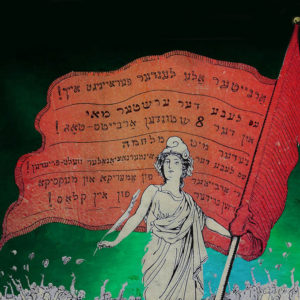 JR: Tell us a little bit about the history of Yiddishkayt. What was the broader social or political background from which it originated?
JR: Tell us a little bit about the history of Yiddishkayt. What was the broader social or political background from which it originated?
CF: Yiddishkayt began in 1995 as a live cultural festival in Los Angeles, but it has deeper roots. The original Yiddishkayt is part of a tradition of leftist and communist-affiliated Yiddish cultural organizations. Many members of the organization’s first board of directors and its original supporters were active members — or children of members — of the International Workers’ Order (IWO). The IWO was a left faction that grew out of the Arbeter Ring/Workmen’s Circle during a political rift in 1922 over responses to the Russian Revolution. Formally established in 1930, the IWO had 13 different sections based on language and ethnicity. The Jewish section (later renamed the Jewish People’s Fraternal Order) was the largest. With more children enrolled in its school network than any other Jewish organization, it became of the most important LA Jewish organizations in the period.
During the McCarthyist witch hunts among Hollywood leftists and Jews, the IWO-JPFO was a clear target. It also became the prime anti-communist scapegoat inside the community as Jewish leaders and organizations attempted to publicly distance themselves from left wing politics under the siege of state-based anti-communist campaigns. With the help of the Jewish community establishment and social democratic organizations like Arbeter Ring/Workmen’s Circle, the IWO-JPFO was added to the state’s list of “subversive” organizations and the Jewish section was destroyed.

Since 2011 Yiddishkayt has continued this radical tradition as a year-round festival of Yiddish culture through online exhibitions and travel programs, like the Helix Project, the summer travel program I direct. Using Yiddish as a lens, we take students, artists, and educators to the borderlands of historical Jewish Lithuania, an area that today spans most of contemporary Belarus, Lithuania, and parts of Poland and Latvia.
Our guiding principle is promoting the idea of hybrid cultures — Yiddish is a classic example of hybridity. It’s a middle-high German language written in the Hebrew script, full of Slavic and Romance influences. We start from the premise that Yiddish culture is a world culture, created in conversation with many other cultures around it over time. This is in stark contrast to the kind of institutional multiculturalism talked about today, where cultures have a kind of separate-but-equal status. We’re more interested in the ways cultures collaborate and influence each other than neat boxes of individual cultures. We don’t see Yiddish as the sole property of a particular ethnic group, but a model for thinking about and creating borderless cultures today.
JR: One of the particularly important contributions of Yiddishkayt is that it promotes a history of Jewish communities that has tended to be eroded by the more dominant (or certainly more vocal) nationalist narratives of Zionism. Could you say a bit about the politics of this decision? And do your students tend to appreciate this in political terms?
CF: There’s a terribly inaccurate back-shadowing in Jewish politics today, as if Zionism has always been the sole or loudest or most representative voice. This idea is at best lazy and at worst reactionary. Jewish politics is made of every kind of socialism, anarchism, territorialism, autonomism, communism, and labor Zionism you can imagine. One of the major political movements we talk about during the Helix Project is the General Jewish Labor Bund in Lithuania, Poland, and Russia. The Bund was a revolutionary socialist group that organized Jewish workers and fought in the 1905 and 1917 revolutions. It created radical cultural organizations, presses, schools, and theaters.
We don’t just speak about the Bund because we find it interesting, but because it was the most popular Jewish political movement in history. I visited a Jewish museum a few years ago with a timeline of important historical events, naming 1897 as the first Zionist conference. That’s true, but completely absent was reference to the foundational meeting of the Bund in 1897: a clandestine group of radicals in an apartment in the imperial Russian town of Vilnius. Avoiding the guards across the square at Lukiškės Prison, we now take students and artists to this site, to sing Bundist anthems and talk about their political and cultural practice.
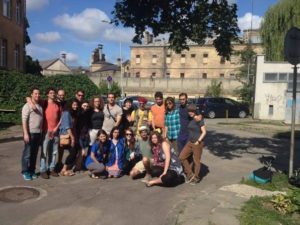
One of the models we use at Yiddishkayt is based on the term “doikayt,” which in English roughly means “here-ness” and refers to a kind of presentism. This is a descriptor for the Bund’s political and cultural framework. Bundists understood that fighting for Jewish self-determination wouldn’t be any easier over “there” in Palestine or in any other potential future autonomous region for Jews. Liberation required a class fight against Tsarism, and against Jewish workers’ own bourgeoisie. The early Bund’s conception of fighting for liberation “here” and “now” also meant seeing their liberation as tied up with every oppressed person and nation in the Russian Empire.
It goes without saying that the Holocaust leaves an irreparable mark on Jewish politics. For groups like the Bund, whose ideology focussed on remaining in Europe and fighting racism there, the Holocaust is held up as a refutation. The teleology goes: if living among non-Jews leads to genocide then it’s a failed strategy, and therefore Jews need a nation state for protection. That understanding of Jewish national self-determination is of course the most common one today, but part of what we do on the Helix Project is sideshadowing. We walk down the alleyways of other historical possibilities, rather than looking at the present moment as an historical inevitability. One of the points we make really clearly on the program is that just because someone was murdered, it doesn’t mean their ideas or political project was wrong. It just means that they were murdered.
Many students who apply to the Helix Project are drawn to the program for political reasons, I certainly was as a student in 2013 although I wouldn’t say this is the primary motivator. Some are activists looking for ways to inform their political practice. Often participants are interested in exploring different ways of being Jewish and understanding Jewish history, and that can take all kinds of different personal, political, and academic forms. This is common in Yiddish circles generally, people are drawn to the culture because it can open up all kinds of alternatives to the mainstream Jewish identity and research trifecta today: Israel, Holocaust, and religious observance.
JR: So, would it be fair to call this ‘alternative heritage’ travel? A kind of non-Zionist equivalent of the Israeli state’s ‘birthright’ trips?
CF: We discuss different travel program models including Birthright, and the ways people encounter ideas of ancestral homeland and national ownership. A travel program like Birthright that visits Israel with the intention of fostering Israeli nationhood sets up a particular historical narrative and norms for its participants.
There are growing travel program options to Europe or Europe and Israel combined, some of them with a “heritage” focus and others with a conflict resolution or genocide studies perspective. We don’t fall into either category. It’s impossible not to encounter the marks of mass murder in the areas we travel on the Helix Project. But we deliberately shift the focus from historical endpoints toward a millennium of lived Jewish culture in the borderlands of Eastern Europe. These places are dotted with historical blood libels and pogroms and they are spoken about as if hatred and animosity are the norm. They’re not the norm. Jews lived regular lives, they went to market, they operated in multilingual spaces with their neighbors, they wrote poems, they opened vegetarian restaurants, they built revolutionary barricades.
I’m reticent to call the Helix Project a heritage program at all, although there is certainly a demand for this today. Young Jews are breaking with uncritical support for Israel or institutional Jewish politics and searching for different ways to feel connected to their cultural history. Many of our students fall into this category in some fashion. While that’s a welcome shift, we’re less interested in facilitating this personal heritage connecting. Yiddish is a world culture as rich as any other and we think their poets, playwrights, and painters are worthy of study regardless of whether people have a familial connection to them. We also differ from heritage programs in that we have no ethnic or religious restrictions on participation and gladly welcome applicants with no Jewish heritage, identification, or academic background in Jewish studies. I would call this is a “Jewish adjacent” program, but I wouldn’t call it a Jewish heritage travel program.
In fact, our programming deliberately broadens out the focus from Jewish culture in isolation. We declaim Yiddish poems every day, but we also read poets like Adam Mickiewicz. This is a perfect example of what we’re trying to do: Mickiewicz is the classic Polish romantic poet, widely touted as the “national poet” of Poland. But he was part Jewish, his hometown is in contemporary Belarus, and his famous epic poem opens as an ode to Lithuania. We have a special place in our Helix Project songbook for Belarusian-language wedding laments. We celebrate the Baltic pagan god of thunder, Perkūnas, at Lithuania’s oldest oak tree.
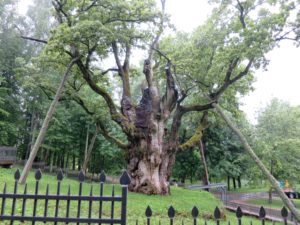
This is not to say that the Helix Project is de-personalized. Quite the opposite; every step of the program encourages us to think about the personal things that motivate our interests. If students go away from this program feeling deeply, personally connected to Yiddish culture because it’s human culture, if they embrace Yiddish art with joy, then that is a victory. Because the field is so dominated by genocide studies, people are sometimes confused (or hostile!) about our lack of focus on the Holocaust. We’re interested in uncovering the real roots of racism and the possibilities for defeating it. That begins with questioning the lachrymose narratives of European Jewish history and looking at the lived reality of Jews and their neighbors in Central and Eastern Europe.
And I want to return to your question about “birthright.” Take Sejny, a town we travel to in northeastern Poland, for example. The area was once home to Poles, Jews, Lithuanians, Russian old believers, Roma, and Tatars. There is a very strong historical memory of that diversity in the town today. What does it possibly mean for one group to have an inherited “right” to a place like that? If this program challenges the idea of a “birthright” at all, then that too is a victory.
JR: A big part of your work is not only exploring alternative histories, but also introducing students to some of the lesser known figures among Eastern European Jewish writers. Who are some of the writers or artists that you explore in your courses? Do you think there exists a certain anti-nationalist, Eastern European Jewish ‘canon’?
CF: When most people think about Eastern European Jewish history, Fiddler on the Roof comes to mind, some funny curse words that have made their way into American English, and maybe deli food (depending on where you live). This unfortunate caricature of a cute, old world, dirty-joke culture is a script we want to flip.
In all Yiddishkayt’s programming we elevate lesser known figures, our website is full of profiles of cultural producers and activists like this. One of our digital projects is a collaboration between an artist and academic who both came on our travel program in 2015. Art Is My Weapon explores Lin Jaldati, a Holland-born performer who sang anti-fascist Yiddish anthems all over the Soviet Union and its allies after her liberation from Nazi concentration camps. The co-creators perform Jaldati cabarets around the US and world and we have an internet home for them.
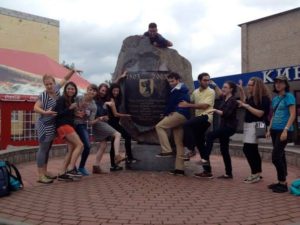
One of our guiding cultural figures on the Helix Project is Meyshe Kulbak, our poet laureate of the region. He wrote a novel that was serialized in the Yiddish press in the early Soviet Union. His novel, Di Zelmanyaner, documents several generations of Jews from their apartment courtyard in Minsk as they live through the revolutionary period. We read his vignettes in contemporary Minsk courtyards and his poem about bear-training in his hometown Smarhon (an actual historical home to bears and their trainers). We stop at the former site of the Institute for Belarusian Culture, where Kulbak and other Yiddishists worked in the Jewish section. We also visit the forest where Kulbak was murdered by the NKVD in 1937.
We explore the avant garde visual artists like Lissitzky, Malevich, Pen, and Chagall. Some of us might know Chagall as a Parisian expressionist, but he also founded the revolutionary People’s Art College in Vitebsk. He was charged with curating a public celebration of the revolution in 1918 — something I’m looking forward to reimagining when we go to Vitebsk in 2017, the centenary! Lissitzky is known for his suprematist painting in some circles, but lesser known for his work on ethnographic expeditions documenting Jewish life along the Dniepr and writing about the painted insides of wooden synagogues.
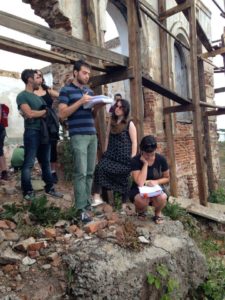
Aside from the work of this period being beautiful, fascinating, and lesser known, it’s also interesting to think about the possibilities for publicly funded culture today in an era of neoliberalism and privatization. In the early revolutionary period Yiddish had official status in the Byelorussian Soviet Socialist Republic and was one of the few places in the world you could be paid as a Yiddish cultural producer. Resource accessibility, a hostility toward Soviet cultural movements, and anti-communism mean it’s only very recently that these Yiddish artists have received any scholarly or artistic attention.
We’re certainly interested in writing back in these artists who have been left out of canons of all kinds: Jewish, Yiddish, Soviet, or modernist canons. But I’m wary about retroactively naming an anti-nationalist canon. There were all sorts of political debates in Yiddish publications and throughout the Yiddish-speaking world about nationalism, anti-nationalism, national autonomy, and self-determination. Yiddish writers and artists were often politically aligned, but they went through different political and linguistic affiliations over time, like all people do. What we can say is that there’s a multiplicity of political allegiances and cultural production among Yiddishists and anti-nationalism features strongly in that.
JR: Since the collapse of state socialism across Eastern Europe there has been a wave of historical revisionism concerning WWII. Specifically, we have seen nationalist intellectuals seek to downplay or at times even justify participation in the 2. In Hungary and Poland far right governments have promoted anti-Semitic ideas and quite vocally anti-Semitic groups have risen to positions of prominence within the opposition in Ukraine. How do you account for this rise and does it impact on your work?
CF: Holocaust revisionism and anti-Semitism are certainly issues we confront in our work and it’s part of a broader nationalist agenda that we see all over the continent and, perhaps, much of the world. Right wing populist governments in Eastern Europe are peddling a slate of homophobic, sexist, racist, Islamophobic and anti-immigrant ideas and policies, including anti-Semitism. One of the discussions I have with my students is that these aren’t issues unique to Eastern Europe and that reactionary ideas can grow anywhere if there isn’t a strong left to counter them — EU reactions to refugees, right wing populist parties in Western Europe, the mainstream Brexit campaign, and Donald Trump all unfortunately underscore that point.
The last decade of institutional Holocaust revisionism is an unavoidable political backdrop to our work. In 2008 the Czech government launched the Prague Declaration, signed mostly by Eastern European politicians and community members, that calls for public condemnation of communism’s crimes. There have been several related proposals since, like calls to prosecute communist war crimes in the same way the Nuremberg trials prosecuted Nazis; joint days of remembrance for victims of both Nazism and communism; and broadening the definition of genocide to include things like mass population transfers and the cultural/political repression Soviet-occupied countries experienced during the twentieth century.
These measures can be seen as attempts to acknowledge the very real suffering people experienced living under totalitarian state socialist regimes. But beneath the surface, nationalist governments and organizations have an interest in pushing this revisionist historical equivalence to draw attention away from the Holocaust and local nationalist complicity in it, obfuscate Nazi collaboration, and shore up contemporary political legitimacy. In these countries with long histories of occupation and national oppression, there is a mythology built up claiming that Jews had a hand in this, especially during the Soviet period. The logic follows that revenge against Jews during the war can therefore be justified, or that there is at least an historical equivalency between the Holocaust and the kinds of repression other national groups suffered under Soviet occupation. It’s politically convenient to say all crimes were equally bad and all occupations were equally totalitarian and violent, because it means never confronting issues like local Nazi collaboration, reparations, or the historical results of extreme nationalism and the horrors it might unleash today.
There’s also a resurgence of anti-Semitism in these countries as people search for scapegoating answers to economic crisis and feel the imperial tug-of-war between the West and Russia. Especially in places like Ukraine, where the independence movement and anti-Russian opposition has a strong connection to the German occupation during the war, anti-Semites get a lot of airtime. Both sides of the conflict are couched entirely in nationalist terms, which only encourages a general climate of xenophobia. Stock stereotypes of Jews as communist oppressors, conspiracies of Jewish banker and media cabals have been re-ignited in some political and intellectual circles.
You are also right about the right wing populist government in Poland. For the last two years I haven’t visited there with the Helix Project, but we’ll return in 2017. There’s a controversial debate around a proposed museum merger in Gdansk and how much public history exhibitions should focus on international narratives of victimhood and resistance versus a particularly Polish national narrative. I would say again that the issue of revisionism or potential Holocaust obfuscation here have to be understood in their context: the attacks on abortion rights, state-sanctioned homophobia, and the general right wing agenda of the PiS-led Polish government.
JR: Obviously, your trips to Eastern Europe take you to places where once thriving Jewish communities were destroyed during WWII. What has been your experience of going ‘back to’ Eastern Europe with your students? Have these trips caused any kind of controversy given the historical and political backdrop you have just identified? Or have you found people there particularly welcoming?
CF: Going to a tiny village in rural Belarus with a group of Americans to declaim Yiddish poems or sing socialist anthems always raises plenty of eyebrows, but we find people to be overwhelmingly welcoming.
One of the things we work against is the idea of going “back to” to Eastern Europe. Our “doikayt” model teaches us to look at the places we travel in the present moment. We don’t visit these towns with the intention of finding an original homeland or the essence of ourselves. What we encourage is a critical engagement with nostalgia and a sense that returning home to Eastern Europe at this juncture is imaginary.
We talked about anti-Semitism before, but my experience traveling in Belarus, Poland, and Lithuania is that these ideas don’t evenly trickle down to ordinary people. We have the occasional local guide who only wants to tell us about the Jewish banks and Jewish business-savvy in a particular town; they see this as a kind philo-Semitic compliment to an imaginary Jewish entrepreneurial spirit, which is really only the other side of the anti-Semitic coin. We sometimes see racist graffiti in abandoned synagogues or the marks of vandalism in Jewish cemeteries. There are real-world effects of the institutional anti-Semitism we discussed, but in my almost annual travel to these places since 2008, individual acts of vocal anti-Semitism aren’t generally something we encounter on the ground.
I’ve hung out with people in Vilnius who want to talk about the Yiddish words they know have entered Lithuanian or want to discuss the similarities they see between anti-Semitism and the difficulties they’ve faced organizing pride parades in the city. One of our local partners in Poland is non-Jewish but works to publicly commemorate the Jewish community of Bialystok, adamant that you cannot understand the history of the town without its Jewish presence.
In Belarus especially there is a strong historical memory of Jewish communities there. We can almost guarantee an elderly person will find us in any rural town we visit and show us a Jewish mill, ruins of a ritual bathhouse, or other site they remember from before the war. Young people there are curious too, I think in part because they’re interested in their own minority culture and how it fits into a heavily Russified Belarusian state today. As I’ve mentioned, we don’t have a Holocaust focus on our program. But when locals we meet want to take us to the Soviet-style monuments marking mass graves in their towns, we go, because we know they are telling us they remember the Jewish presence across the region and its place in their community.
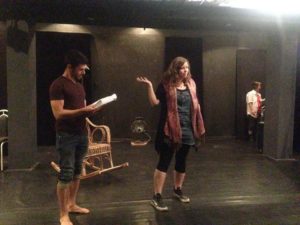
Clare Fester is the Associate Director at Yiddishkayt.

